You’ve heard it all before, countless times. You know social media is important for your business, but you don’t know where to start.
Planning a successful social media campaign might seem incredibly time-consuming, but it doesn’t have to be.
All you need is a bit of inspiration and a strong planning process.
To help with the latter, we’ve created a free social media campaign planning template to guide you through the process (and we’ve got a few examples for inspiration below too).
In this post, we’ll walk you through how to use this template step by step and also look at:
- What a social media campaign looks like
- How to create a solid campaign plan
- How to put your plan into action and launch your campaign
Let’s get to it.
What exactly is a social media campaign, anyway?
At its core, it’s a marketing campaign that’s created to achieve a business goal using social media. A bit vague, we know.
The reality is, a social media campaign can be almost anything—there are almost as many varieties of them as there are businesses in the world.
What it isn’t: random general posts that you post to your social media channels. The key word here is campaign: a social media campaign has to have a coordinated series of posts with a very specific goal behind it.
What kinds of social media campaigns are there?
Again, there are many, and they vary depending on what the campaign goal is and what resources business have at their disposal.
Here are three of the most popular types of social media campaigns:
Giveaways
Giveaways are, dare we say, the most popular kind of campaign.
Brands love using giveaways to increase their engagement and grow their audience. We see this across industries—from Mala the Brand, a handcrafted candle company that created an eco-conscious-themed giveaway, to Mana Poke, a poke bowl restaurant that teamed up with a local food blogger for their giveaway.
And we can’t blame them. The upfront costs of giveaways are next to nothing, while the likelihood of getting more comments and new followers is high.
Make sure the entry guidelines you set directly contribute to your campaign goal.
For example, if you want to increase engagement on your social media channels, ask people to like and comment. Want to grow your audience? Ask people to tag a friend or two.

Pacific Sands Beach Resort’s giveaway campaign on Facebook.
Remember that any contest or giveaway will have to abide by the rules of the platform it’s hosted on. A few things to look out for would be age limits, location restrictions, and what information you’re allowed to collect from people. Make sure you’re checking the fine print there.
Influencer Partnerships
While you may have heard of the rise (and fall) of the influencer, they’re definitely not out for the count.
In influencer partnerships, the influencer accepts products or monetary compensation in exchange for creating content to promote your brand.
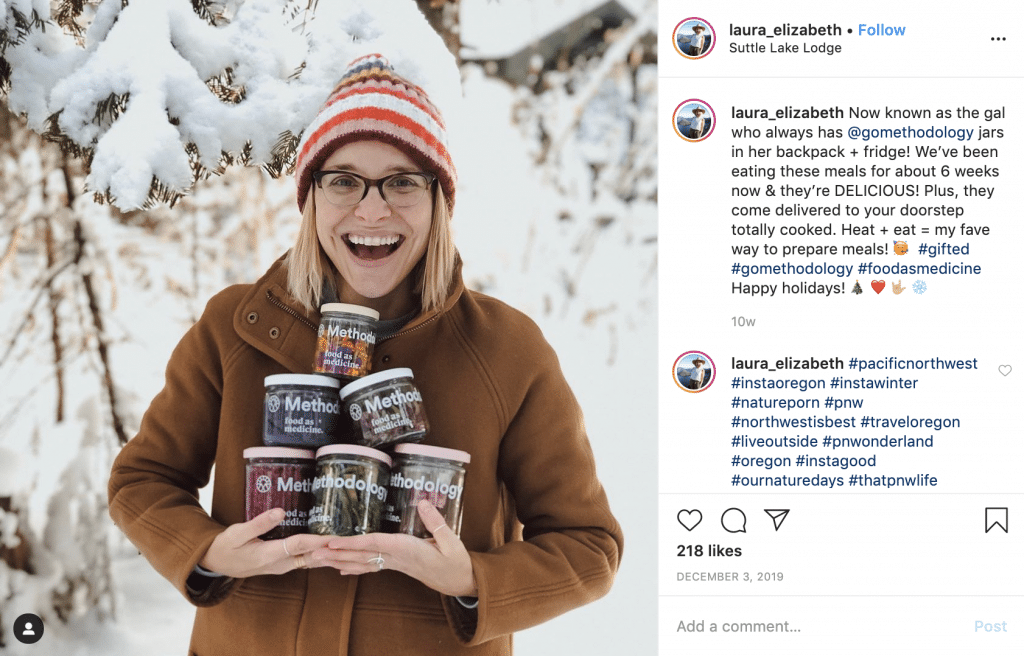
Laura Arbo promotes Methodology, a meal prep service, on her Instagram.
Brands have been finding success with micro-influencers (who have anywhere from 10,000 to 100,000 followers) and, most recently, with nano-influencers (1,000 to 10,000 followers).
Why bother with nano-influencers? Well, while nano-influencers have a smaller following, they tend to have more engaged audiences and lower rates. They’re a good place to start if you’re looking to explore influencer partnerships and don’t want to invest a ton of money off the bat.
UGC (user-generated content) contests
Collecting user-generated content is a huge win for any brand. Why? Because it engages your audience and provides you with content you can use later on. Utilizing a social wall can enhance this process significantly.
UGC is any form of content, such as images, videos, or text, that has been created and published by social media users—and that you don’t have to pay for.
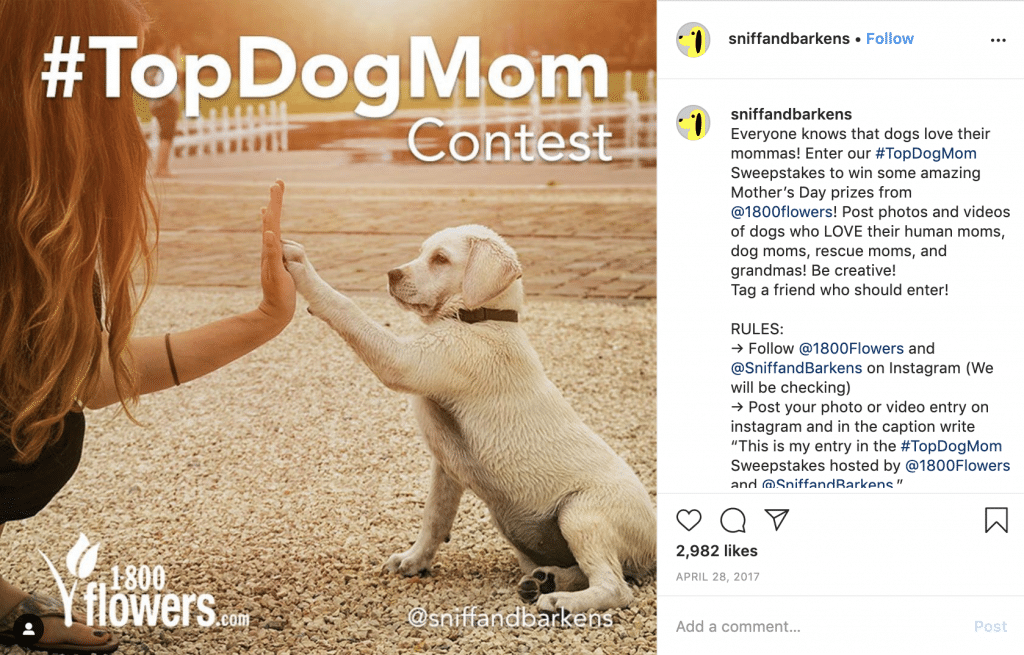
Sniff and Barkens’ #TopDogMom photo contest for their Mother’s Day campaign.
While UGC doesn’t always have to be collected through a contest, doing so definitely helps you collect it faster. Plus it means the users—your audience—will get a reward out of it as well.
Before we dive into the planning process, let’s get inspired.
A few social media campaign ideas to help you plan
Burger Revolution: a play on UGC
Burger Revolution is a restaurant in Ontario, Canada, specializing in house-ground craft burgers, fries, and poutine (a Canadian treasure).
When looking at their Facebook and Instagram, we can see they’re playing to each platform’s strengths and using that to inform what they post on each channel.
While Burger Revolution’s Instagram mainly displays drool-worthy photos of their burgers, their Facebook is used to engage with their community.
They do this by sharing content from their customers, but not in the way most restaurants might do. Burger Revolution has an ongoing social media campaign called “Comment of the Day.”
Inside the restaurant, they have a board where customers can post comments or doodles on a sticky note. Every day, one of these sticky notes gets posted on their Facebook as the comment of the day:
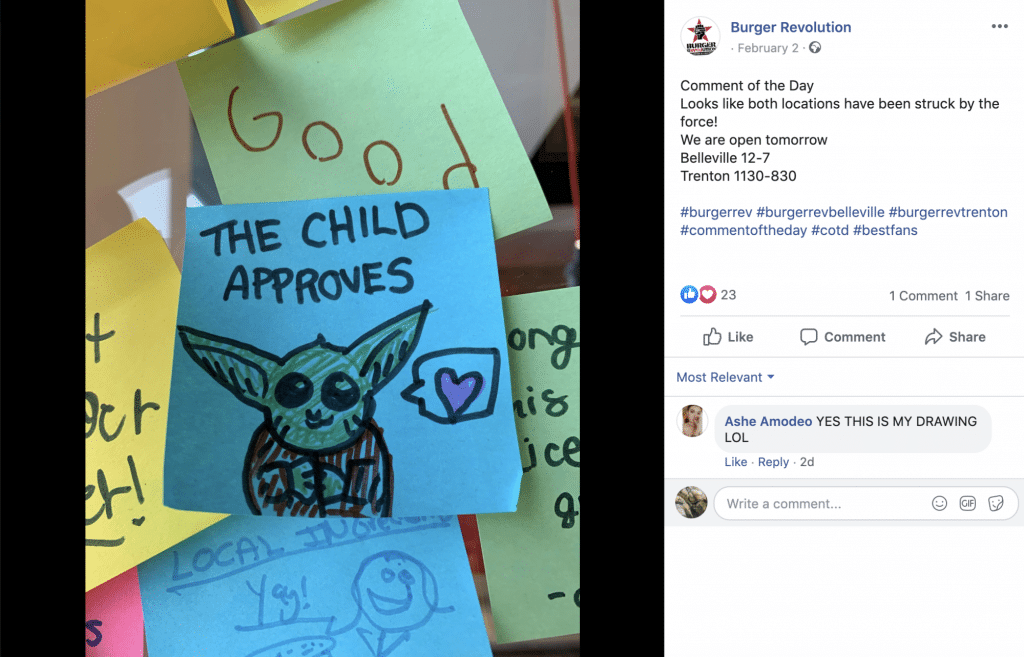
Burger Revolution’s Comment of the Day Facebook campaign.
Why it works:
It’s a fun, easy way to build and engage Burger Revolution’s community, both online and offline.
Restaurant patrons may see the board and then like the Facebook page to see if their comment will make it up there. (You can see in the screenshot above that one user posted that the Comment of the Day was their drawing!)
Those who already follow the page will keep an eye on it to see which comments make it as the chosen one of the day.
With this campaign, Burger Revolution has a steady flow of incoming content that they don’t have to create themselves. That’s social media gold.
Bonus: This particular Comment of the Day features Baby Yoda, a meme that blew up on social media in the span of a few days.
By choosing a topical comment, Burger Revolution can easily increase their engagement based on whatever big cultural events are happening. (They do this most often with holidays and major sports games.)
What they could also try:
Burger Revolution’s Facebook posts with the highest engagement feature their staff—either photos of them in the kitchen or little blurbs about what they’re up to that day.
A way to build upon this would be to involve staff in the Comment of the Day campaign in order to increase engagement.
Maybe one day a week, the chosen comment could be from a sticky note a staff member wrote. Another option could be to have staff members choose the Comment of the Day and post a photo of themselves with the sticky note.
Curiouser Shop: 9th birthday giveaway
Curiouser and Curiouser is an independent print and gift shop in Edinburgh, Scotland.
They recently launched a social media campaign to celebrate their ninth birthday by having nine days of giveaways. A new item was up for grabs each day:
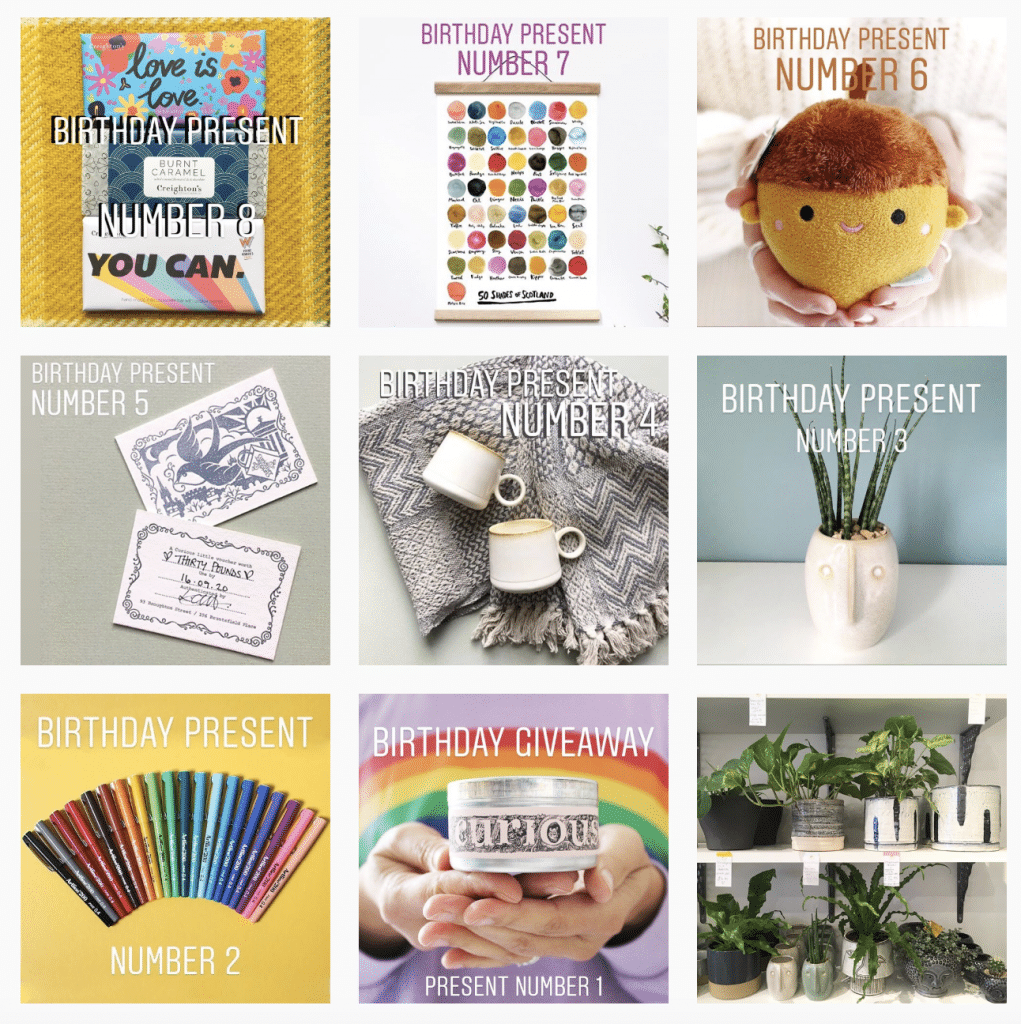
Curiouser’s birthday giveaway social media campaign.
Why it works:
By having the giveaway span a nine-day period, Curiouser widened their window for higher engagement. That’s nine days of increased likes, comments, and friend-tags.
They kept the giveaway fresh by having nine different items and a new twist to each day’s entry requirements. While leaving a comment was a requirement on most days, the comment prompt would be themed around that day’s giveaway item. Clever.
Curiouser also asked their audience to tag a friend as an entry requirement on some days. By switching between this and leaving a comment, they were increasing both their community engagement and audience size.
Finally, all the posts were written with personality. Their brand voice really comes through in each one, with personal stories from shop owners and cute comment themes like “Comment below and tell us, if you won today’s prize, what would you call this wee guy??”
What they could also try:
While Curiouser did have a birthday sale happening in store, they could have used their captive social media audience to promote a special sale for those who had seen the giveaway online.
Having a sale exclusively for their social media audience would make their community feel like they were still getting a reward, even if they didn’t win the giveaway. And the element of exclusivity would likely increase their number of store visits.
Now that you’ve seen a few social media campaign examples, it’s time to roll up your sleeves and get started on one of your own.
How to create your social media plan in 4 steps
A great campaign starts with great planning. You can speed things along by using a social media campaign planning template like the one we have for you here.
It’ll guide you through each step of the process, saving you loads of time and guesswork.
Step 1: Determine your goals, your target audience, and your channels
First, we have to lay the foundation.
What’s your goal?
Before you figure out what you’re doing, you need to figure out why you’re doing it. What do you want to get out of your campaign?
It’s important to always determine your goal first. It’ll inform all the planning that comes after it—your idea, which platforms to choose, what to post, and which metrics to track.
The more clear and specific your goal is, the better. That way when you’re deciding on an idea or details of your campaign, you’ll be guided to choose the options that are most conducive to your goal.
These are some of the most common social media campaign goals:
- Raise brand awareness
- Increase followers
- Boost sales
- Grow community engagement
- Promote an event
- Drive website traffic
Once you have a primary goal (and maybe a secondary one), you’ll need to tie them in to metrics. By keeping track of your channel metrics, you’ll have a better idea of how your campaign performed.
Different goals will connect to different metrics. For example, if your goal is to grow your channel engagement, your metric might be the number of comments on a post.
Tracking metrics might sound like a giant, time-consuming task. But it doesn’t have to be. Focus on a few, impactful metrics that are closely connected to your campaign goal.
If your campaign goal is brand awareness, you could track it through impressions—the number of times your content is displayed to users.
Another common goal is to increase engagement (likes, comments, and shares). The focus here is your engagement rate—the number of those engagement actions relative to your number of followers. This is an important one because a higher engagement rate means your content is resonating with your audience.
Don’t worry. You won’t have to manually figure out these numbers. Most of the major social media management tools like Buffer, Sprout Social, and Hootsuite, have built-in tools to measure metrics.
Determine your audience
Who are you targeting in your campaign? Remember that you have a general audience on your social media channels, but your target audience for your campaign is different from that.
It could be your best customers or maybe a specific group within your total social media audience.
For example, if you’re a restaurant, you might create a campaign promoting vegan menu items to people who are currently vegan or looking to try veganism. Or if you’re a barbershop, you might create a campaign targeting men with beards.
Pick your platforms
You might feel like you need to be on all the major social media platforms, but that isn’t the case. You don’t want to spread yourself too thin and not have enough time to create quality posts.
The channel(s) you choose for your campaign will inform what kind of content you post as well as what engagement options you can use. For example, on Instagram you can interact with your audience using Stories to create polls, countdowns, and question boxes.
Consider your industry and your brand when making your choice. It’s also important to consider your audience. Where do they (and their friends) hang out online?
Odds are it’ll be on one of the big three platforms:
Facebook is the biggest social media platform, with the highest number of users worldwide. You’ll find a very wide range of audiences here, but with dwindling numbers of active millennials and almost no Gen Z presence.

Cotopaxi, a sustainable outdoor apparel company, educates their audience by using #GearForGood—a company ethos and an ongoing social media campaign.
Facebook’s algorithm changes have also made it difficult to reach your existing audience, even if they’re following your page. But there are ways to work with the algorithm rather than against it.
The upside is that Facebook has an incredibly powerful advertising functionality with very specific demographic targeting. It’s easy to use if you’re interested in Facebook advertising.
The biggest benefit of Instagram is that there are so many ways to engage your audience.
In addition to the usual photo and video posts, there are Instagram Stories and IGTV. Within Stories itself, there are options for your audience to vote in polls, answer questions, and complete quizzes.
The platform’s shop functionality has also become a powerful tool to increase revenue on a platform that’s already pretty good at driving sales.
Unfortunately, Instagram algorithms have changed recently as well, limiting how much of your audience will see your posts. It’s not all bad, though. These changes have made small communities with high engagement very valuable.
If your brand is highly visual, Instagram is the first platform you should jump on:

BETA5’s eye-catching Lunar New Year campaign featuring themed chocolates and cream puffs.
People used to predict that Twitter would eventually become obsolete, but it’s still alive and thriving.
Twitter emphasizes real-time information and is used for news, entertainment, politics, sports, and knowledge-sharing.
You can take advantage of this by sharing blog posts and promotional updates on Twitter, where users are already in a frame of mind to read news. Sharing those same things may not work as well on Instagram, where users might be in a more relaxed or shopping frame of mind.
It’s great for engaging one-on-one with your audience and having conversations with potential customers.
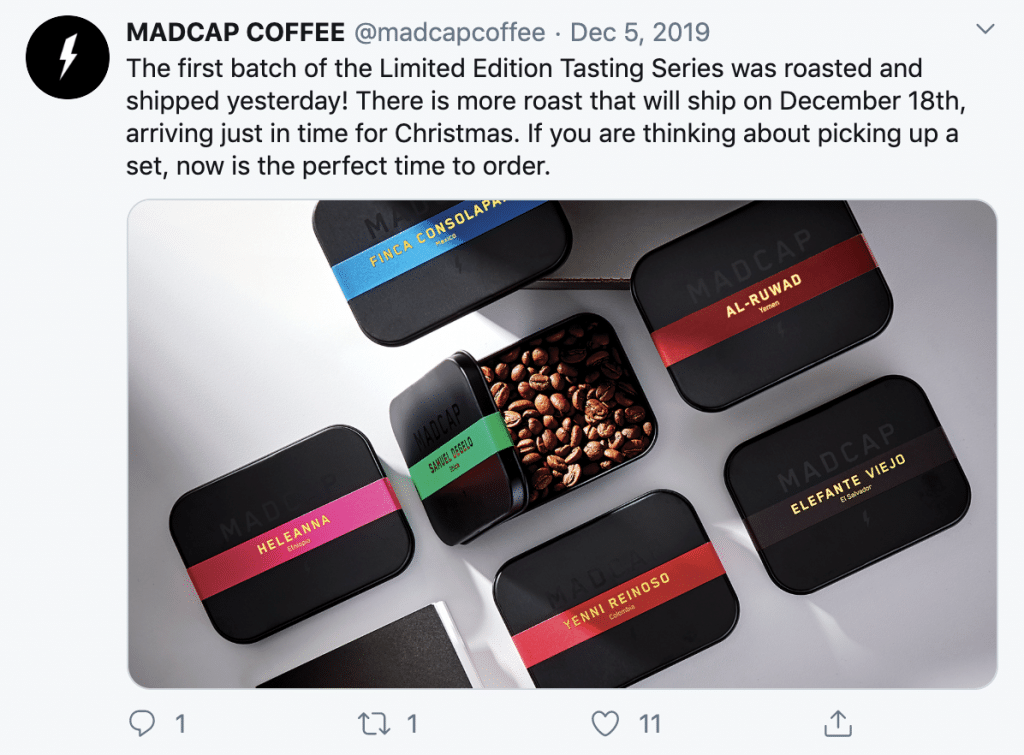
Madcap Coffee uses Twitter to update their audience about their Limited Edition Tasting Series.
Step 2: Lay the foundation
Whether you’ve already been posting on social media or you’re just starting from scratch, you want to make sure your platforms are on-brand and ready to be seen by (hopefully) more people.
First impressions matter, and the same goes for social media profiles.
Determine your brand voice
Whether it’s for your regular social media posts or for your campaign posts, you want to keep everything consistent in tone. That’s where your brand voice comes in.
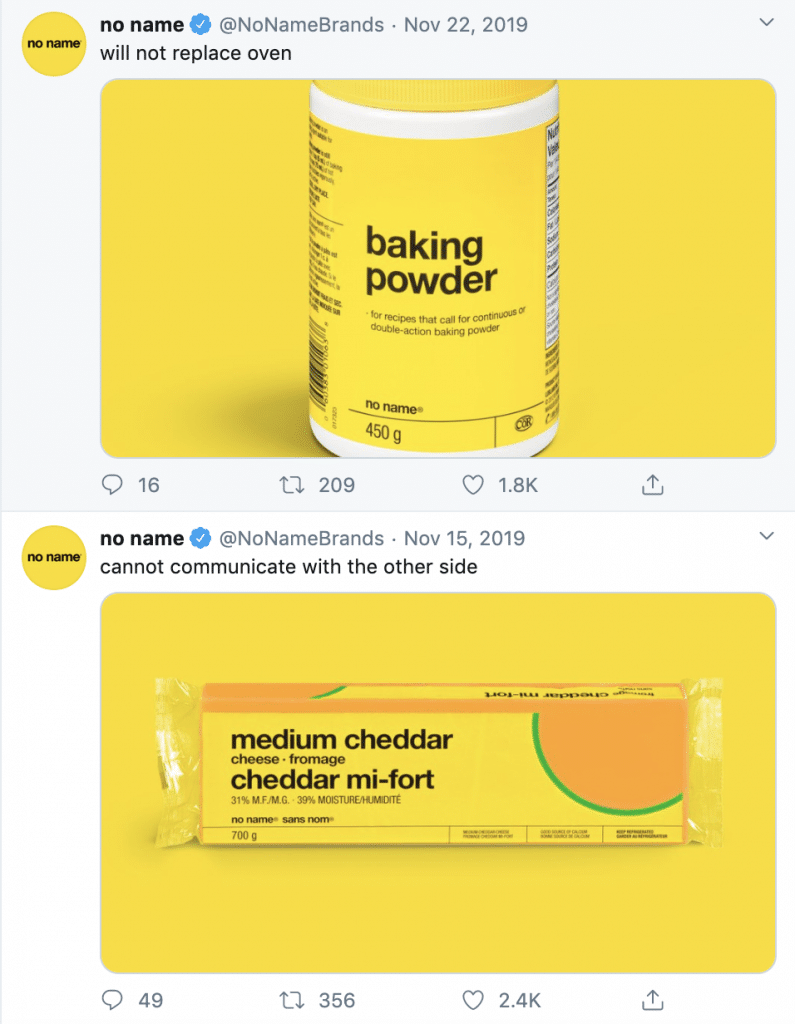
No Name creates a strong brand voice by using dry humor and informal sentence structure.
Think of your brand as if it were a person. How would you describe them? Choose three words that you’d like your brand to fully embody.
Make sure these characteristics come through in your posts—and resonate with your audience. For example, if your audience is older and more conservative, you probably don’t want to have an edgy brand voice like Nakid Magazine:
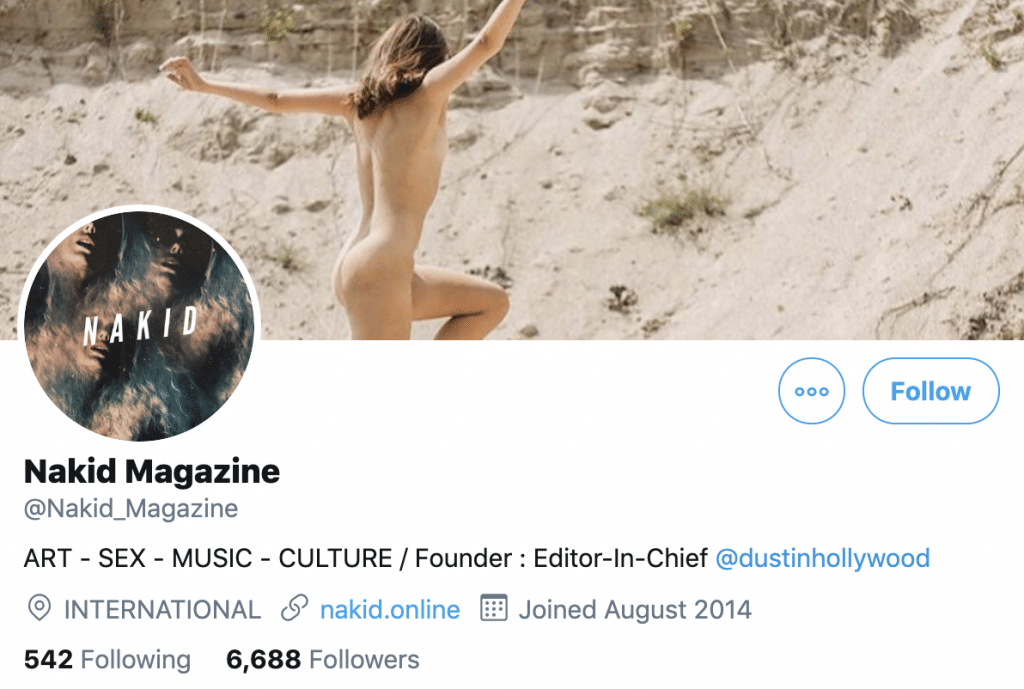
Nakid Magazine’s bold brand voice on social media.
Make sure your social media profiles are consistent.
Now that you have a brand voice, update your profiles to align with it.
Here are a few quick wins that will make a huge difference with very little work:
Use the same profile picture across all your social media channels. This will typically be a version of your company logo that has been modified to be social-media-friendly.

Firebox, an online retailer that curates unusual gifts, keeps their profile picture and brand consistent across Instagram, Facebook, and Twitter.
Doing this will make your brand look more put-together and will also increase your brand recognition across different social media platforms.
Fill out all your profile blurbs. These should succinctly provide information people may be looking for when they view your profile, like what you offer or when you’re open.

HausWitch maximizes their Instagram bio by including what they’re about, when they’re open (both online and offline), and the best way to get in touch with them.
Be sure to complete the general contact sections for phone number, address, and email as well.
Finally, come up with your campaign idea
Yes, the idea. It’s what will drive your entire campaign.
The question is, how does one come up with a creative idea for a social media campaign?
A good place to start is to think of the top one or two problems your audience has. And then, think of how you can solve that problem for them.
This is a great opportunity to brainstorm with your team. Staff working in different positions may have different insights into your customer base.
Have a quick meeting with everyone to come up with ideas that might be fun on social media. If you have teammates working out of different locations, you can try using a platform like RingCentral’s desktop and mobile app to instant-message and collaborate during the brainstorming process:
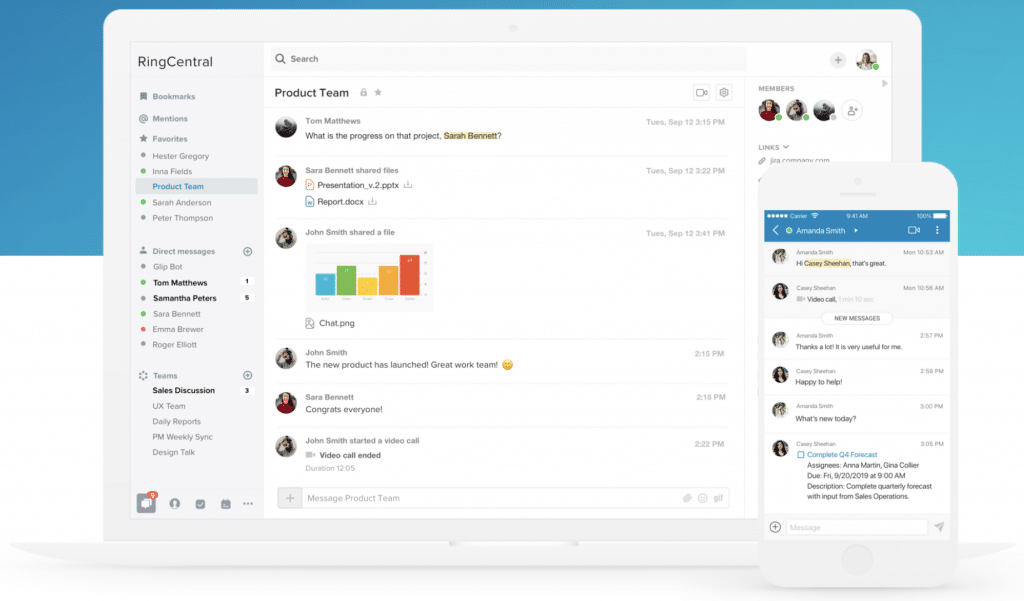
RingCentral lets your team message each other in real time, share files, and even create channels and teams for specific projects—like planning a social media campaign!
If you need a little inspiration, sneak a peek at what your competition is up to on social media. Odds are you’ll see something that’ll spark an idea in you.
Now that you have a nugget of an idea, it’s time to mold it into the campaign it’ll become.
Step 3: Solidify your campaign plan
Determine your posting frequency
The easiest way to do this is to take a step back and think of your campaign as a whole.
The main things you need to decide are:
- How many posts will be part of your campaign
- How spaced out they’ll be, and
- How far out these posts will be published
For example, let’s say you’re planning a Fourth of July sale. You may want to start posting about it at the start of June or maybe even in May depending on how big of a sale it is. If the sale continues on for a week, it would be a good idea to include a post after it’s already begun as well for a final push.
There are best practice frequencies for each of the channels, but it’s okay to be realistic about how much time you have. Quality will always trump quantity.
When you’re thinking of how often to post, don’t forget to consider what your campaign posts will look like mixed in with your regular posts. You don’t want your audience to feel like they’re constantly being sold to.
SAD Mag, an independent arts and culture magazine, promoted their Future Issue with a seven-day countdown on Instagram. By alternating between a campaign post and a regular post, they kept the Future Issue top-of-mind for their audience without overly promoting it:
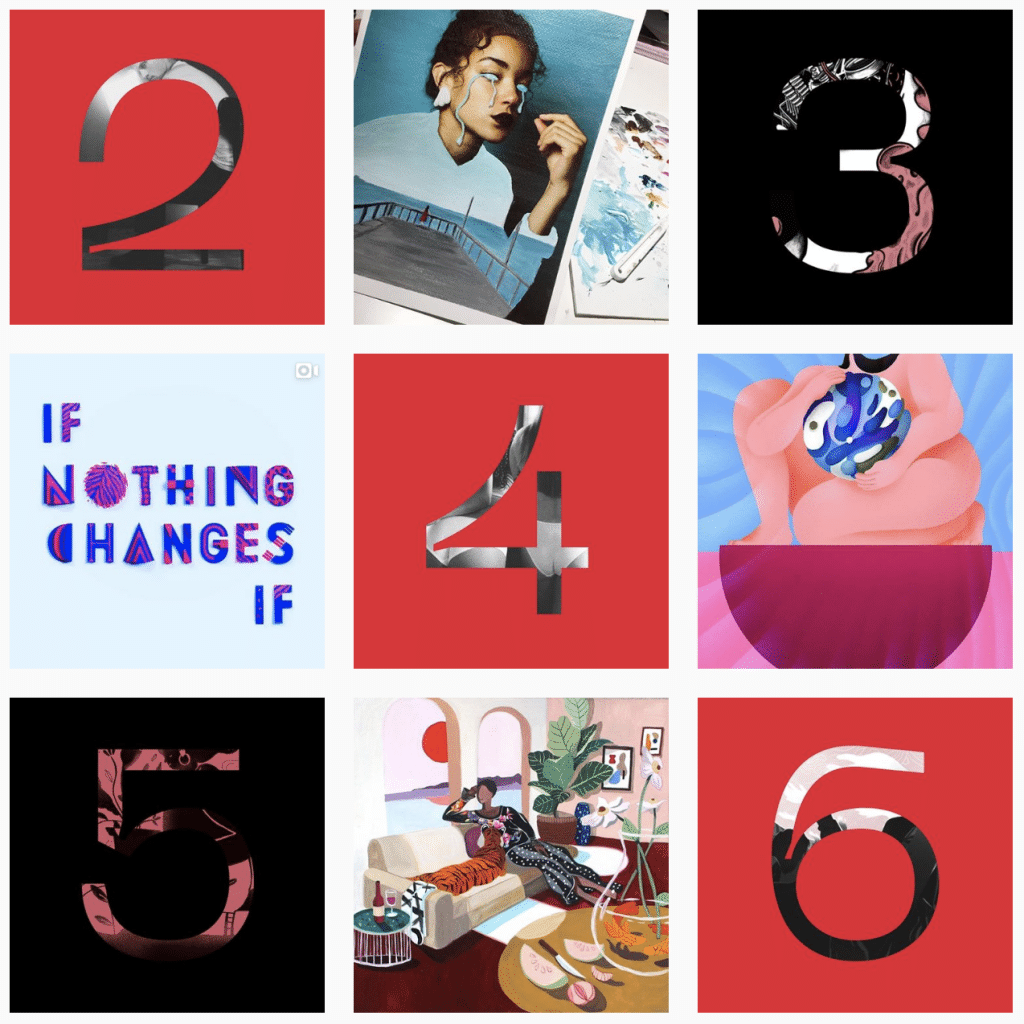
SAD Mag’s social media countdown to the Future Issue.
It’s okay to go with your gut and try what feels right to start. You can always test different posting times and frequencies and make adjustments.
Choose your content types
There’s a wide variety of content types that can be used to get your message out, but some will work much better than others when it comes to your specific campaign.
First, consider your brand and your audience’s interests. A quick way to figure out what your audience likes is to look back at your previous social media posts and see which ones had the most engagement.
What did they have in common? Look out for things like content type (e.g., photos vs videos), content subject matter (e.g., people vs products) and content tone (e.g., informative vs comedic). Start with those elements.
From there, add in a few other content types.
You’ll get the best results by mixing up your content. If you stick to the same thing day after day, your audience will eventually get bored and stop engaging with your posts.
Some of the most popular content types include:
- Photos
- Videos
- Memes
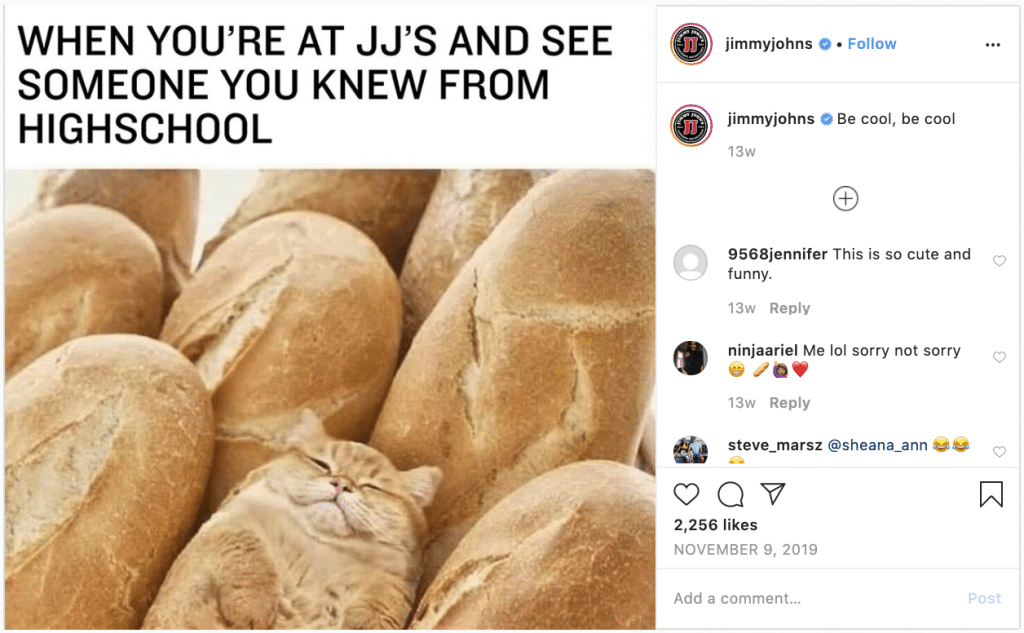
Jimmy John’s often posts relatable memes on their Instagram.
- GIFs
- How-tos
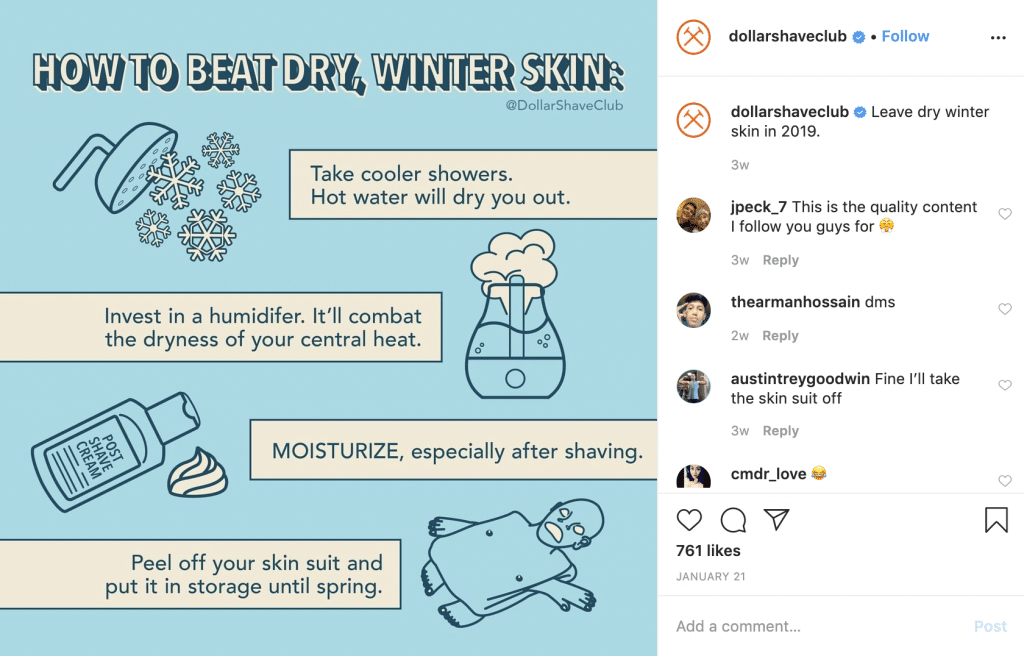
Dollar Shave Club adds a comedic twist to a how-to post on Instagram.
- Infographics
- User-generated content
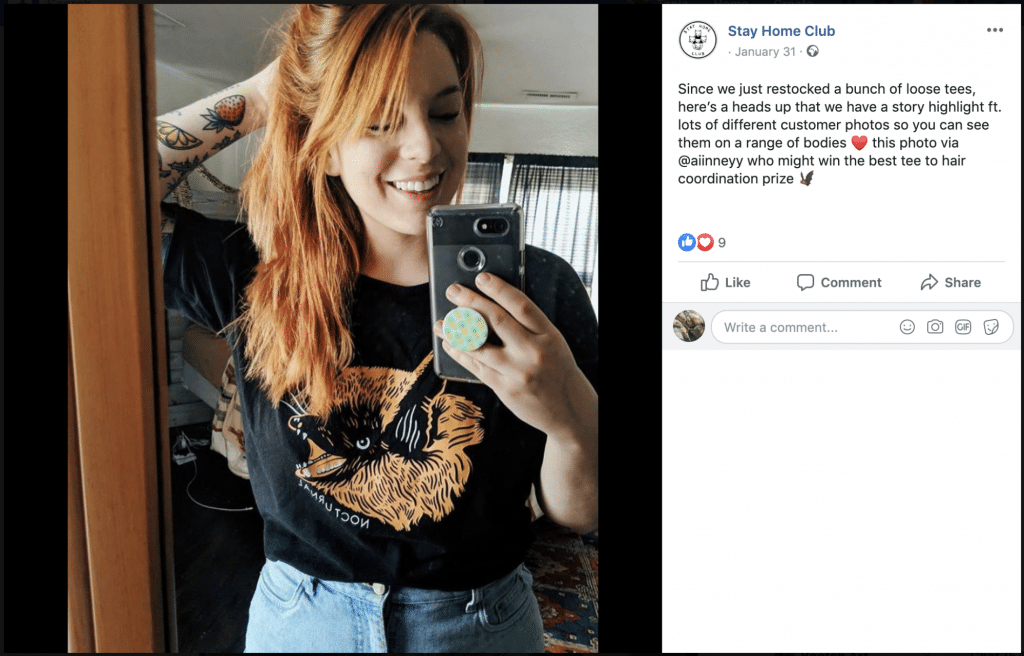
Stay Home Club’s use of user-generated content to promote their clothing restock.
Okay, you’re just about ready to start creating your campaign content. To maintain your sanity, you’ll need a way to keep track of all your content and the posting frequency.
Keep organized with a content calendar
When planning posts for a social media campaign, you need somewhere to keep track of everything.
If you have a post going out on Thursday and three posts going out each week for the next month and a half, things can get confusing very quickly.
Enter the social media content calendar. It’s exactly what it sounds like: a calendar of what content is being posted on which channels and when.
A social media content calendar can be as simple or as robust as you’d like it to be. Some people prefer spreadsheets, while others prefer more platforms with scheduling and reporting functionality. A few of the ones we’d recommend would be Buffer, Hootsuite, and Sprout Social.
Try a few different ones out and see which feels most intuitive to you.
Step 4: Put your campaign plan into action
The time has finally come to put your social media campaign plan into action! Let’s get started.
Write your post copy
As you begin to write your social media posts, keep these things in mind:
- Does this post align with my campaign goal?
- Do these posts need to be in sequential order?
- Is this post a good fit for the platform it’s being posted on?
- What kind of visual aspect would go with this post?
For social media, a good rule of thumb is to not make your post copy longer than it needs to be. Each platform has different character limits, but regardless of what the maximum is, try to keep your posts less wordy if you want people to read them.
Be sure to shorten your links as well using a link shortener like Bitly or TinyURL. Paste your long URL into these converters, and they’ll spit out a much shorter, tidier URL that works the same as your original one. There are even options for custom URLs so you can include your brand name in your new, shortened link.
Depending on your brand, you can add emojis to your copy as a fun touch.
Once you have the copy, you can move on to the visual aspect.
Create your visual content
The visual side of your social media post should complement the copy. And ideally, all the visuals on your channel should complement each other.
The easiest way to do this is to keep your visuals within one general color palette. Having a consistent aesthetic strengthens your brand image and makes your channels more pleasing to the eye.

Adored Vintage sticks with neutral tones on their social media, even though not all their available clothing falls within that color palette.
Try to avoid switching back and forth between photographs and graphics. Sticking to one or the other will help your campaign have a consistent look.
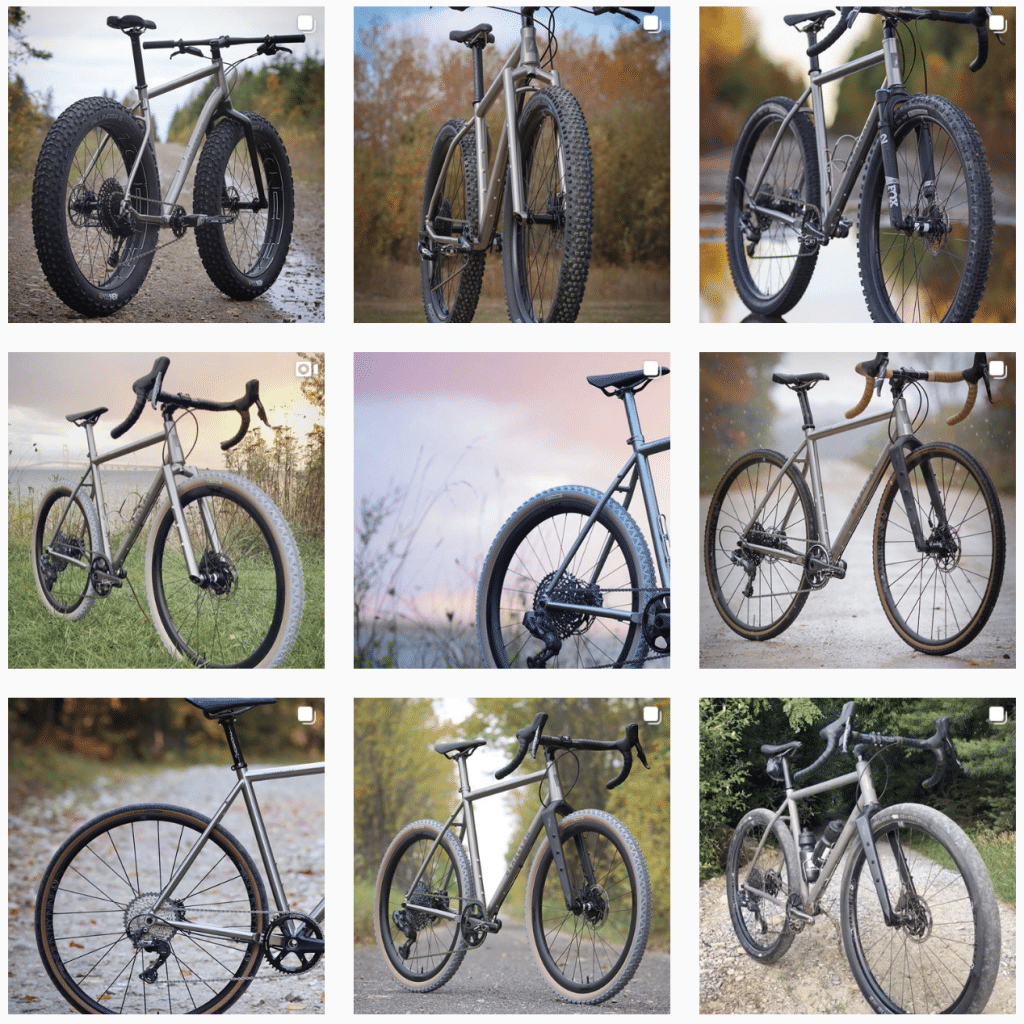
Bearclaw Bicycle Co. keeps their Instagram simple and consistent with photos of bicycles outdoors.
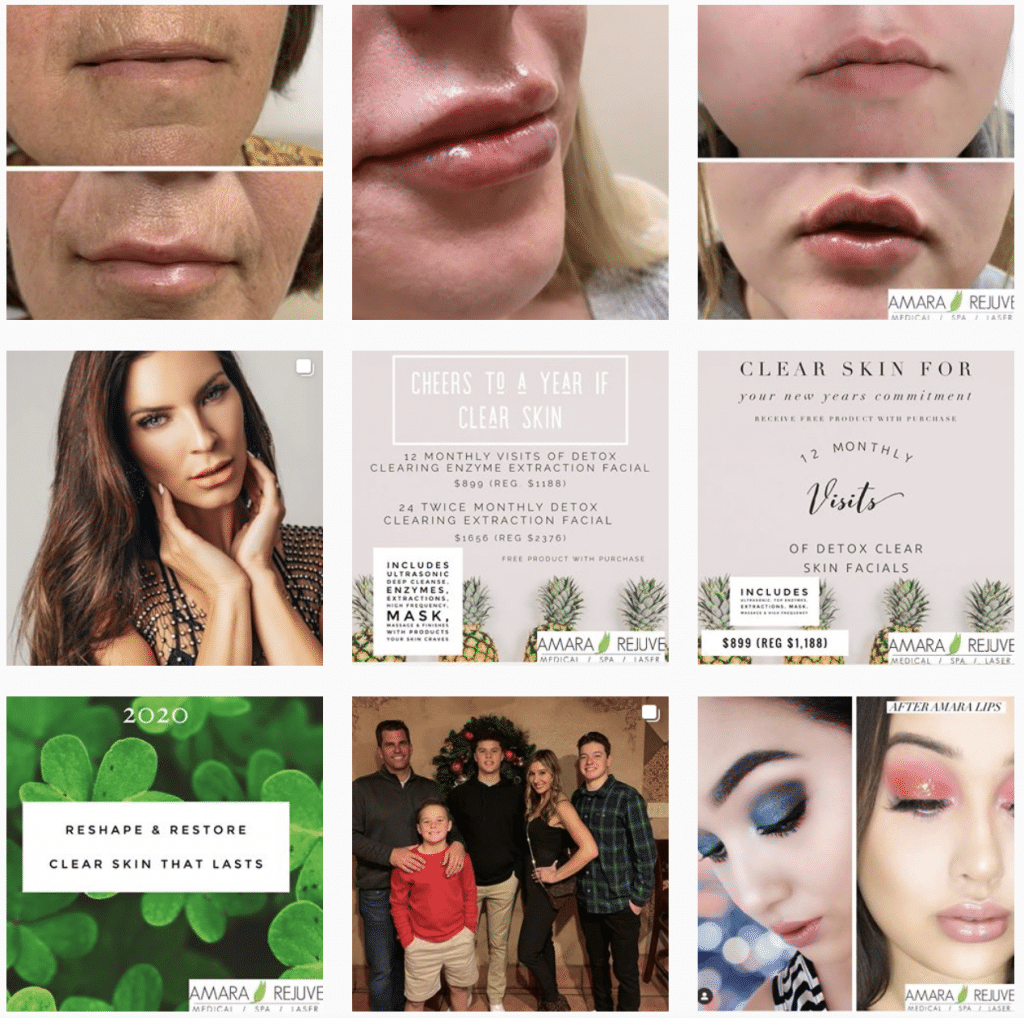
While Amara Rejuve Medical Spa does a great job of showing off their before & afters, they could strengthen their brand image by keeping consistent with the type of content they post as well as their color palette.
Not a designer? Not to worry.
There are plenty of tools available that let you create beautiful graphics without any design experience. A few of our favorites include Canva and Crello.
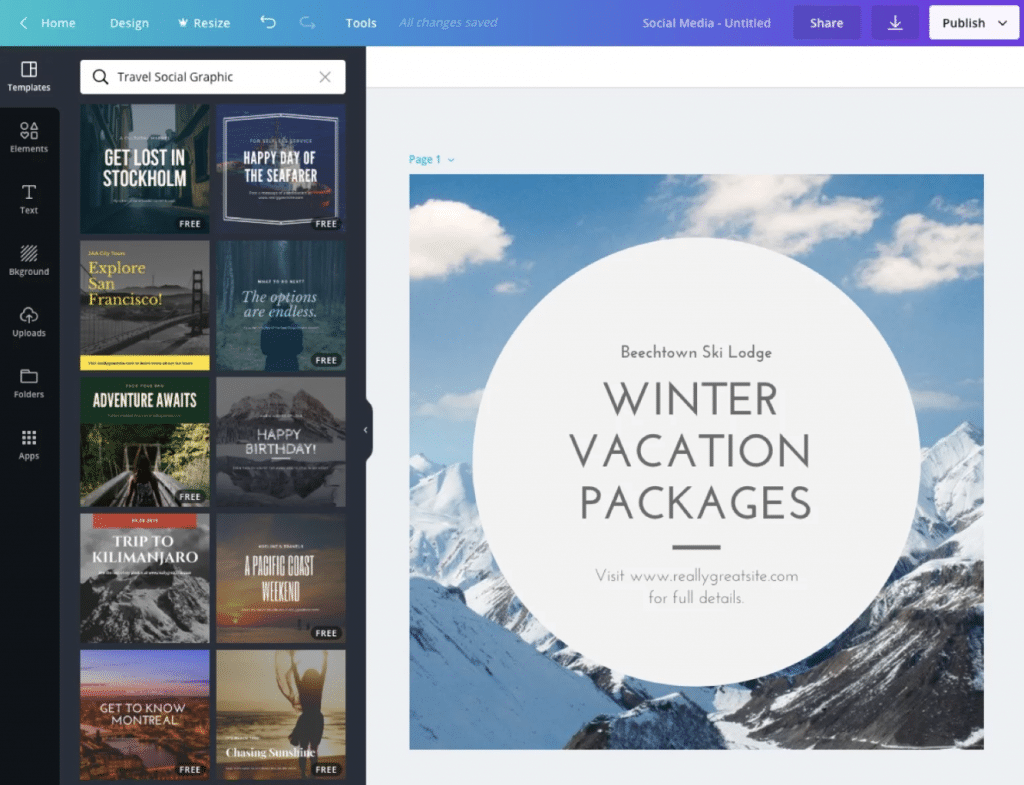
Canva has over 50,000 templates and a drag-and-drop feature that makes it easy for anyone to create beautiful graphics.
Launch your campaign!
All that’s left to do is to get posting.
While you can post your content manually, you’re better off scheduling your posts using the social media management tools we mentioned earlier—Buffer, Hootsuite, and Sprout Social.
As your social media campaign posts start rolling out, keep an eye on your channels to get a general sense of how things are going.
And whenever you find a minute or two, be sure to engage with your audience. For example, reply to their comments and answer their questions. A little goes a long way.
Congrats, you’re now a pro at social media campaign planning
The quickest thing you’ll learn doing social media campaigns is that it’s all trial and error.
Once your campaign has run its course, take a moment to think back to the beginning of your planning process.
What was your primary goal? And what metric was connected to it?
Have a look at your results to see where you did well and what you could improve on next time.
From there, it’s about re-assessing your campaign goals, tweaking your strategy, and trying it all over again.
But now that you’ve done it once, things will go more quickly next time. Use the social media content planning template again and slot in your new idea.
Next time, your social media campaign planning will be (even more of) a breeze.
Originally published Feb 01, 2020, updated Nov 20, 2023





